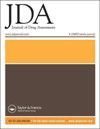Patiromer and maintenance of RAASi therapy in hyperkalemic medicare patients
IF 2.4
引用次数: 1
Abstract
Abstract Background: Renin angiotensin aldosterone system inhibitor (RAASi) therapy is part of the cornerstone of therapy for patients (pts) with cardiovascular disease including hypertension, CHF, and/or CAD, but use is often limited by the development of hyperkalemia. Patiromer (PAT) is a sodium (Na)-free non-absorbed potassium (K+) binder approved for hyperkalemia (HK) treatment. Patiromer has been shown to reduce recurrent HK and allow pts to maintain RAASi. Aims: This retrospective cohort study evaluated RAASi utilization among Medicare Advantage pts with HK. Methods: RAASi utilization was evaluated from a large, de-identified national health insurance claims database, Optum Clinformatics Datamart, from Janaury 1, 2016 to December 31, 2017. Three HK cohorts were identified: (1) patiromer (PAT cohort) or (2) sodium polystyrene sulfonate (SPS cohort), or (3) HK diagnosis code without K+-binder prescription (NoKb cohort). Pts were included who had a pre-index serum K+ ≥5.0 mEq/L and were continuously exposed to RAASi for ≥6 months pre-index (i.e. index date is date of first K + binder dispensing or HK diagnosis). Exposure during follow-up was classified as intent to treat (ITT) and continuous exposure (CE). ITT follow-up began on the index date and ended at the first censoring event (i.e. plan disenrollment, death, December 31, 2017) or 6 months post-index while CE also included censoring for discontinuation or switching of binder therapy (i.e. PAT or SPS). RAASi continuation and down-titration (the latter assessed for lisinopril, losartan, and valsartan) were assessed at 6 months post-index. Results: The study population included: 214 PAT pts, 2371 SPS pts, and 8531 NoKb pts. Overall, the mean age was 75 years and 50% were male. Pt comorbidities (all cohorts): CKD (48%), ESRD (1%), CHF (23%), and DM (54%). At 6 months post-index, 102 (ITT)/36 (CE) PAT pts, 1,627 (ITT)/35 (CE) SPS pts, 5,543 (ITT)/5,127 (CE) NoKb pts were evaluated. RAASi continuation rates for CE were 78%, 57%, and 57% and for ITT were 63%, 52%, and 56% in the PAT, SPS, and NoKb cohorts, respectively. Down-titration rates for the CE/ITT groups were 13/9%, 6/7%, and 7/8% in the PAT, SPS, and NoKb cohorts, respectively. Conclusions: At 6 months post-index, among continuously exposed patiromer pts, a high RAASi continuation of ∼80% was observed. RAASi continuation for pts in the SPS and NoKb cohorts was <60%. Down-titration rates of RAASi in all three cohorts were low (∼10%). Further study is warranted to fully elucidate these findings.高钾血症患者RAASi治疗的临床应用和维持
背景:肾素血管紧张素醛固酮系统抑制剂(RAASi)治疗是心血管疾病(包括高血压、心力衰竭和/或CAD)患者治疗的基石之一,但其使用往往受到高钾血症的限制。patromer (PAT)是一种无钠(Na)非吸收钾(K+)结合剂,被批准用于治疗高钾血症(HK)。parromer已被证明可减少复发性HK并使患者维持RAASi。目的:本回顾性队列研究评估了RAASi在医疗优势患者中的应用。方法:从2016年1月1日至2017年12月31日的大型、去识别的国家健康保险索赔数据库Optum Clinformatics Datamart中评估RAASi的使用情况。确定了三个HK队列:(1)patiromer (PAT队列)或(2)聚苯乙烯磺酸钠(SPS队列)或(3)无K+结合剂处方的HK诊断代码(NoKb队列)。纳入指数前血清K+≥5.0 mEq/L且指数前连续暴露于RAASi≥6个月的患者(即指数日期为首次K+黏结剂分配日期或HK诊断日期)。随访期间暴露分为意图治疗(ITT)和持续暴露(CE)。ITT随访从索引日期开始,并在第一次审查事件(即计划退出,死亡,2017年12月31日)或索引后6个月结束,而CE还包括审查停止或切换粘合剂治疗(即PAT或SPS)。RAASi的继续和下降(后评估赖诺普利,氯沙坦和缬沙坦)在指数后6个月进行评估。结果:研究人群包括:214名PAT患者,2371名SPS患者和8531名NoKb患者。总体而言,平均年龄为75岁,其中50%为男性。Pt合并症(所有队列):CKD (48%), ESRD (1%), CHF(23%)和DM(54%)。6个月后,评估102 (ITT)/36 (CE) PAT点,1627 (ITT)/35 (CE) SPS点,5543 (ITT)/ 5127 (CE) NoKb点。在PAT、SPS和NoKb组中,CE的RAASi持续率分别为78%、57%和57%,ITT的RAASi持续率分别为63%、52%和56%。在PAT、SPS和NoKb组中,CE/ITT组的降滴定率分别为13/9%、6/7%和7/8%。结论:在指数后6个月,在持续暴露的患者中,观察到高RAASi延续率为80%。在SPS和NoKb队列中,患者的RAASi延续率<60%。在所有三个队列中,RAASi的下降滴定率都很低(约10%)。有必要进一步研究以充分阐明这些发现。
本文章由计算机程序翻译,如有差异,请以英文原文为准。
求助全文
约1分钟内获得全文
求助全文

 求助内容:
求助内容: 应助结果提醒方式:
应助结果提醒方式:


